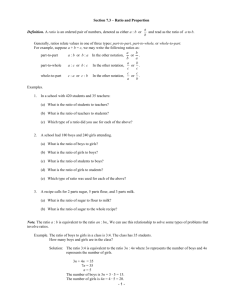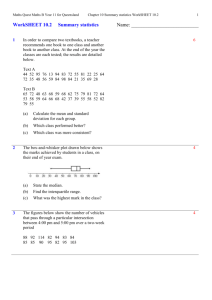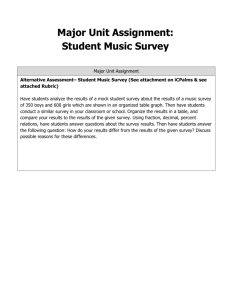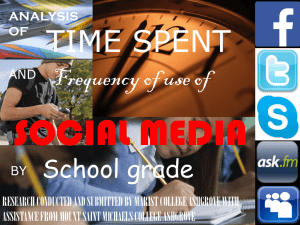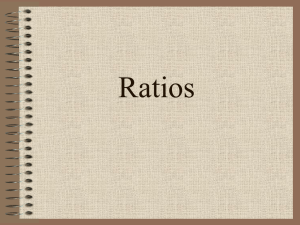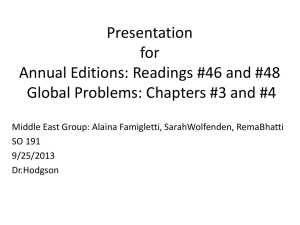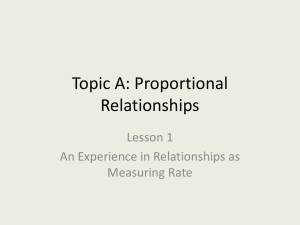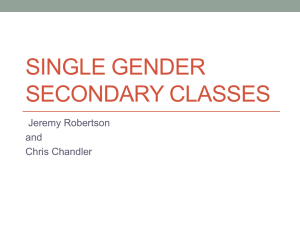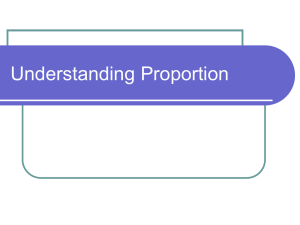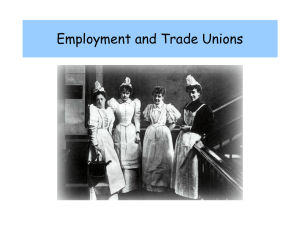Ratio and proportion - Lesson study by St. Patrick`s
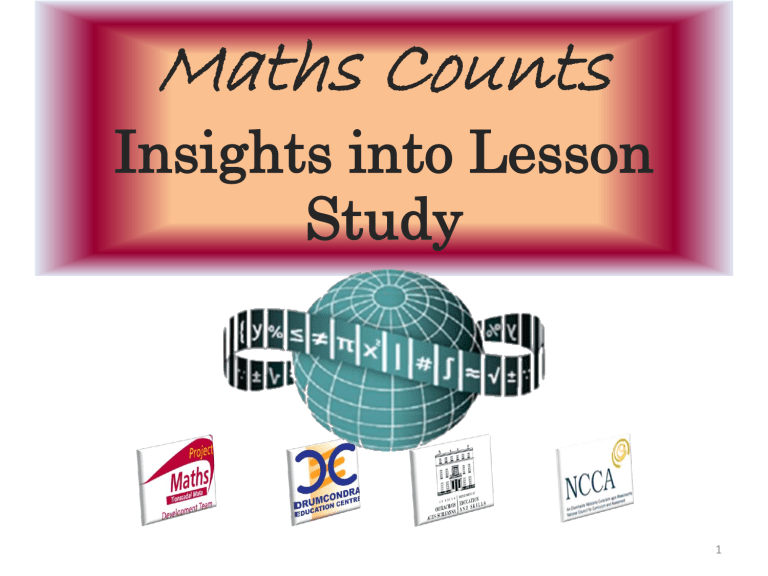
Maths Counts
Insights into Lesson
Study
1
• Yvonne Rice, Aileen Courtney, Fiona Murphy
• TY Foundation level & 3rd year Ordinary Level
• Ratio and Proportion
2
• Introduction: Focus of Lesson
• Student Learning : What we learned about students’ understanding based on data collected
• Teaching Strategies: What we noticed about our own teaching
• Strengths & Weaknesses of adopting the Lesson
Study process
3
Learning Outcomes
o Students will be able to apply their arithmetic skills to simplify simple ratios. o We want students to be able to recognise the use of ratios in a real-life context and allow them to use this knowledge to challenge themselves to solve some difficult word problems hence improving their literacy skills.
4
Resources used
Spider Diagram (Link)
Ratio PowerPoint (Link)
Activity Sheet (Link)
Ratio Theme Park (extension)
5
• Why did we choose to focus on this mathematical area?
• Proportionality is believed to be vital for problem-solving and reasoning, which are key cognitive domains of mathematics teaching and learning.
• Help students with basic operations i.e. operations on fractions, ratios, factors.
• Make maths more applicable to daily life.
12
• Student Learning : What we learned about students’ understanding based on data collected
• Teaching Strategies: What we noticed about our own teaching
13
• Data Collected from the Lesson:
1. Academic e.g. samples of students’ work.
2. Motivation-Were students engaged with activity they were doing.
3. Social Behaviour: Group work and pair work.
14
• What effective understanding of this topic looks like:
• Questions related to money – students seemed to be more engaged when talking about money rather than theoretical use of ratios
• Everyday examples - helped students to relate the topic to their own lives in a practical way
15
16
Incorrect formation of a fraction or
Misinterpretation of the ratio as a fraction
• 1. Cheryl and Ashley share €300 in the ratio
3:7. a. How much does Ashley get? b. How much does Cheryl get?
17
Forgetting to add ratio parts
• 1. Cheryl and Ashley share €300 in the ratio
3:7. a. How much does Ashley get? b. How much does Cheryl get?
18
Unable to Attempt the Question
7. In a secondary school the ratio of boys to girls is
10:11. There are 400 boys in the school.
– a. How many girls are in the school?
– b. How many students are in the school?
19
Not Reading : Not Understanding the Question
• 7 .
In a secondary school the ratio of boys to girls is 10:11. There are 400 boys in the school.
– a. How many girls are in the school?
– b. How many students are in the school?
20
Inability to Work Backwards
• 7. In a secondary school the ratio of boys to girls is
10:11. There are 400 boys in the school.
– a. How many girls are in the school?
– b. How many students are in the school?
21
Recommendations
• Spider Starter & Working back method- Important to show a simplified example on board first.
• Make sure the students know the meaning of the maths language beforehand and be able to work with fractions.
• Important to get students to follow a specific strategy for solving a problem in their own words.
• Students need to take ownership of their work and need to come up with their own examples in groups.
Smoothie Example, Shop Example
22
23
• The understandings we gained regarding students’ learning of Ratio and Proportion as a result of being involved in the research lesson
• Students were afraid to be wrong or attempt answering a question.
• Probing needs to be part of every class and needs to be familiar to the students.
24
• What did we learn about this content to ensure we had a strong conceptual understanding of this topic?
• Make sure the students know the meaning of the maths language beforehand and be able to work with fractions.
• Past experience, research, discussion amongst teachers, self-reflection
25
What did I notice about my own teaching?
• When organising the lesson to pitch to the level of the students.
• Some students are not good with fractions or separating parts especially if the answer was given and they had to work backwards.
• Keeping them engaged and on task organising lesson had to make it simple enough for them
• What is real life to these students? Student’s prior learning
• Our assumptions… We think they can relate to normal everyday examples as been relevant to them e.g. cement example
• Classroom management it is difficult to get around to all groups, especially to the lower ability students
26
• Was it difficult to facilitate and sustain communication and collaboration during the lesson?
• Classroom management was not a problem during this class. It wasn’t difficult to communicate with students during tasks as the noise level during paired work was not high and there were no dominant groups.
27
• Was it difficult to ask questions to provoke students’ deep thinking?
• Students did not volunteer answers at the start of the lesson due to lack of confidence.
Later when students were more sure of their work they were eager to supply answers
28
• How did I engage and sustain students’ interest and attention during the lesson?
• The inclusion of everyday examples and worksheets helped to keep students involved with the topic. Exercises were within students’ capabilities so all were engaged.
• Pitching the tasks to the students abilities was an important factor in sustaining students’ attention.
29
• How did I assess what students knew and understood during the lesson?
• Worksheets
• PowerPoint
• Probing questions
30
• How did I put closure to the lesson?
• I recapped the steps we used to problem solve.
• What changes would I make in the future, based on what I have learned in my teaching, to address students’ misconceptions?
• Students need to take ownership of their work and need to come up with their own examples in groups.
31
Strengths & Weaknesses
• As a mathematics team how has Lesson Study impacted on the way we work with other colleagues?
• This was the first time we compared and contrasted 3 rd Year Ordinary level with TY
Foundation level and identified the same problems in both classes . Peer observation was beneficial in particular the discussion after the lesson to share ideas. It is important to cooperate and share resources.
32
• Personally, how has Lesson Study supported our growth as teachers?
• We have always collaborated as a department but this was a different and interesting type of collaboration. However finding the time for this can be demanding. It is a useful way to try out new resources.
33
• Recommendations as to how Lesson Study could be integrated into a school context.
• Lesson study can be difficult to organise for teachers who have classes timetabled simultaneously. We find that the syllabus is very long and it is difficult to achieve the learning outcomes in the time available.
34


